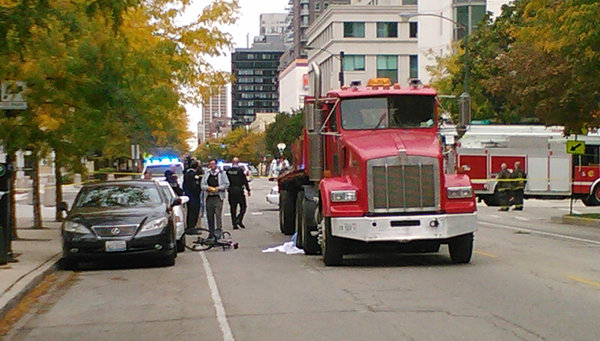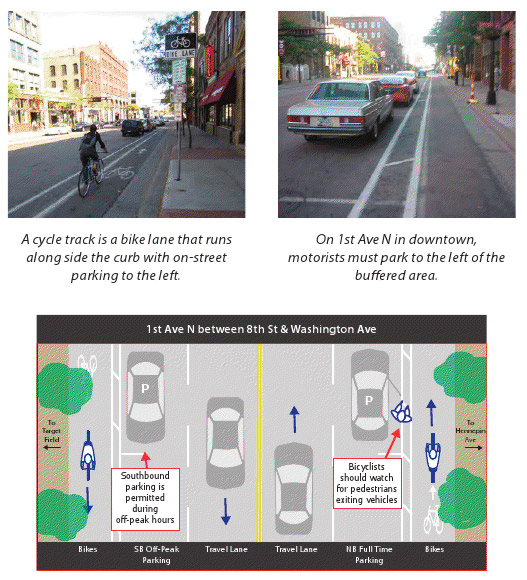
My wife just IM'd me: "did you get struck and killed biking to work this morning?" No; I took the bus because I wanted to read. But the cyclist killed downtown this morning was hit close to my usual route, and in the manner that I fear the most—the cyclist apparently swerved to avoid being doored and fell beneath a semi. It's a frightening scenario, and not swerving won't necessarily protect you; dooring can knock you into traffic (or all the way over the door), depending on where and when the door hits you.
It's a difficult scenario. Picture Milwaukee Avenue from Ashland to Damen for a sense of the problem—it's a narrow street, a major artery that's usually packed with parked cars and cars trying to park. Just that short stretch of the street offers hundreds of chances to be doored, and if you're doored into the street there's little room between the bike and the car. (If you see cyclists riding on the far edge of the bike lane, it's probably because they're trying to stay out of the door zone. Moving cars seem scarier than parked cars, but the drivers are ususally paying attention, and better placed to see bikes in front of them.)
There are actually ways to mitigate this; it's not an inevitability of road design. In San Francisco, some bike lanes are "cross hatched" to encourage bicyclists to stay to the left edge of the lane, marking the area of the door zone, and there's evidence that it's worked:
We’ve done before/after studies on both Polk and Howard where we were able to reduce the number of cyclists riding in the door zone. On Howard Street (study conducted 2006) the average distance from the curb where cyclists rode increased from 10.3 feet to 10.9 feet, with 24% riding in the door zone before and 10% after. On Polk Street (study conducted 2009-10) the average distance from the curb where cyclists rode increased from 10 feet to 10.4 feet, with 41% riding in the door zone before and 30% after.
But it's a half-measure, narrowing down the effective lane practically to the width of the bike, and not a substitute for people being careful about opening their doors:
“I think it’s a really good idea where you don’t have sharrows,” said Hill. “But I think the only problem with it is that nobody understands that very well. I think it’s a good thing to know if you’re a bicyclist, but in my opinion it’s not as good as sharrows at telling motorists that the bicyclist is expected to be there.”
Do people know that the bicyclist is expected to be there? No. Take Mark Konkol, who wrote this in the Sun-Times (emphasis mine):
There’s no point debating the need for these bike lanes, though I could argue the pylon-lined path linking Garfield Park to Douglas Park should include bulletproof vests, and there are no protected lanes where you really need them — Halsted Street, Elston Avenue and, of course, Milwaukee Avenue through Bucktown and Wicker Park, where hipsters on Huffys are constantly crashing into open car doors.
It's an odd way to describe dooring, as if distracted or even malevolent bikers are just trying to plow through car doors as if they were pedaling a tank. There are ways to ameliorate the risk, as a cyclist, such as taking extra caution when a parked car's lights switch off, but sometimes the door is unavoidable.
Steven Vance, whose advocacy got the state to start tracking doorings, is opposed to any bike lanes that run to the left of parked cars, an option being between parked cars and the sidewalk. For example, a cycle track in Minneapolis:

Cyclists can still get doored, of course, but: it's less likely because not all cars have passengers; if they are doored, they won't fall into traffic; and they can't swerve into traffic. But such an infrastructure solution is time-consuming to implement. Until then, drivers simply have to check before opening a door. At WBEZ, Robin Amer (who was doored, and severely injured, riding in Chicago) has more.
Photograph: Chicago Tribune



